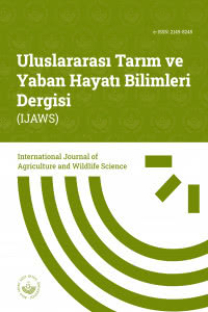Yumurta Parazitoiti, Trichogramma brassicae Bezdenko (Hymenoptera: Trichogrammatidae)’nin Düzce İlindeki Popülasyonları İçerisindeki Genetik Varyasyonların Belirlenmesi
Trichogramma brassicae, yumurta parazitoiti, genetic varyasyon, Düzce
Determination of the Genetic Variation within the Egg Parasitoid, Trichogramma brassicae, Bezdenko (Hymenoptera: Trichogrammatidae) Populations in Düzce Province, Turkey
Trichogramma brassicae, egg parasitoid, genetic variation, Düzce,
___
- Alvarez JM and Hoy MA., 2002. Evaluation of the ribosomal ITS2 DNA sequences in closely related populations of the parasitoid Ageniaspis (Hymenoptera: Encyrtidae). Annals of the Entomological Society of America, 95(2): 250-256.
- Chang SC., Hu NT, Hsin CY and Sun CN., 2001. Characterization of differences between two Trichogramma wasps by molecular markers. Biol. Control. 21: 75-78.
- Cruickshank RH., 2002. Molecular markers for the phylogenetics of mites and ticks. Systematic & Applied Acarology, 7: 3-14.
- Hall TA., 1999. BioEdit: A User-friendly Biological Sequence Alignment [ed.], and Analysis Program for Windows 95/98/NT. Nucleic Acids Symposium Series, 41: 95-98.
- Jeong G., Kim H, Choi Y, Kim W, Park K, Bae S, Park K and Choi J., 2010. Molecular identification of two Trichogramma species (Hymenoptera: Trichogrammatidae) in Korea. Journal of Asia-Pacific Entomology, 13(1): 41-44.
- Knutson A., 1998. The Trichogramma manual, Agricultural communication, The Texas A&M University System, Texas.
- Kimura M., 1980. A simple method for estimating evolutionary rate of base substitutions through comparative studies of nucleotide sequences. Journal of Molecular Evolution, 16: 111-120.
- Kumar GA., Jalali SK, Venkatesan T, Stouthamer R, Niranjana P and Lalitha Y., 2009. Internal transcribed spacer-2 restriction fragment length polymorphism (ITS-2-RFLP) tool to differentiate some exotic and indigenous trichogrammatid egg parasitoids in India. Biological control, 49(3): 207-213.
- Kumar S., Stecher G and Tamura K., 2016 MEGA7: Molecular evolutionary genetics analysis version 7.0 for bigger datasets. Molecular Biology and Evolution, 33: 1870-1874.
- Kutuk H., 2016. Identification and natural parasitism of Trichogramma species on Ostrinia nubilalis Hübner (Lepidoptera: Noctuidae) eggs in Düzce, Turkey. Entomological News, 126(4): 290-298.
- Li Y., 1994. Worldwide use of Trichogramma for Biological Control on Different Crops: A survey. In: Wajnberg, E. and Hassan, S.A. (Eds.). Biological Control with Eggs Parasitoids. Center for Agriculture and Biosciences International. Wallingford, Great Britain. pp. 37-54.
- Meksem K and Kahl G., 2005. The Handbook of Plant Genome Mapping, Genetic and Physical Mapping, Wiley-VCH, Weinheim, 380 p. Nagarkatti S and Nagaraja h., 1977. Biosystematics of Trichogramma and Trichogrammatoidea species. Annual Review of Entomology, 22: 157-176.
- Pinto JD and Stouthamer R., 1994. Systematics of the Trichogrammatidae with Emphasis on Trichogramma. In: Wajnberg E, Hassan SA (eds) Trichogramma and other Egg Parasitoids. CAB Intl., London, pp. 1-36.
- Pinto JD., 1999. Systematics of the North American species of Trichogramma Westwood (Hymenoptera: Trichogrammmatidae). Memoirs of the Entomological Society of Washington, 22: 287-301.
- Smith SM., 1996. Biological control with Trichogramma: advances, successes, and potential of their use. Annual Review of Entomology, 41: 375-406.
- Smith SM and Hubbes M., 1986. Isoenzyme patterns and biology of Trichogramma minutum as influenced by rearing temperature and host. Entomologia Experimentalis et Applicata, 42: 249-258.
- Stouthamer R., Hu J, van Kan FJPM, Platner GR and Pinto JD., 1999. The utility of Internally Transcribed Spacer 2 DNA sequences of the nuclear ribosomal gene for distinguishing sibling species of Trichogramma (Hymenoptera: Trichogrammatidae). BioControl, 43: 421-440.
- Subbotin SA., Sturhan D, Rumpenhorst HJ and Moens M., 2003. Molecular and morphological characterisation of the Heterodera avenae species complex (Tylenchida: Heteroderidae). Nematology, 5: 515-538.
- Sumer F., Tuncbilek AS, Oztemiz S, Pintureau B, Rugman-Jones P and Stouthamer R., 2009. A molecular key to the common species of Trichogramma of the Mediterranean region. BioControl, 54: 617-624.
- Sumer Ercan F., Oztemiz S, Tuncbilek AS and Stouthamer R., 2011. Sequence analysis of the ribosomal DNA ITS2 region in two Trichogramma species (Hymenoptera: Trichogrammatidae). Archieves of Biological Sciences, 63(4), 949-954.
- Sumer Ercan F., Oztemiz S and Tuncbilek A.S., 2013. Mitochondrial and ribosomal sequence analysis for discrimination of Trichogramma euproctis Girault and Trichogramma brassicae Bezdenko (Hymenoptera: Trichogrammatidae). Turkish Journal of Entomology, 37: 195-201.
- Tanha Maafi Z., Subbotin SA and Moens M., 2003. Molecular identification of cyst forming nematodes (Heteroderidae) from Iran and a phylogeny based on ITS-rDNA sequences. Nematology, 5: 99-111.
- Thomson L., Rundle BJ, Carew ME and Hoffmann AA., 2003. Identification and characterization of Trichogramma species from south-eastern using the internal transcribed spacer 2 (ITS2) region of the ribosomal gene complex. Entomologia Experimentalis et Applicata, 106(3): 235-240.
- Waeyenberge L., Ryss A, Moens M, Pinochet J and Vrain TC., 2000. Molecular characterization of 18 Pratylenchus species using rDNA restriction fragment length polymorphism. Nematology, 2: 135-2.
- ISSN: 2149-8245
- Başlangıç: 2015
- Yayıncı: BOLU ABANT İZZET BAYSAL ÜNİVERSİTESİ > ZİRAAT VE DOĞA BİLİMLERİ FAKÜLTESİ
Mevsimsel Varyasyonun Rosmarinus officinalis (L.) Uçucu Yağ Bileşenlerine Etkisi
Türkiye’deki Yerel Phaseolus vulgaris Populasyonlarını Kullanarak Kuru Fasulye Çeşitlerinin Islahı
Mehmet Zahit Yeken, Faik Kanta, Hüseyin Çancı, Göksel Özer, Vahdettin Çiftçi
A Review on Organic Pistachio Growth and Development Opportunities in Turkey
Bahtiyar Buhara Yücesan, İsmail Eker, Noreen Aslam, Luiz Eduardo Santos Lazzarini, Aliyu Mohammed, Jose Eduardo Brasil Pereira Pinto, Wolfgang Kreis, Ekrem Gürel
Türkiye’de Organik Antepfıstığı Yetiştiriciliği ve Geliştirme Olanakları Üzerine Bir Derleme
Zarife AĞGÜN, MUSTAFA KENAN GEÇER, Rafet ASLANTAŞ
Bahattin KARAKUŞ, BİLAL KESKİN
BAHTİYAR BUHARA YÜCESAN, İSMAİL EKER, Luiz Eduardo Santos LAZZARİNİ, Noreen ASLAM, Aliyu MOHAMMED, Jose Eduardo Brasil Pereira PİNTO, Wolfgang KREİS, Ekrem GÜREL
